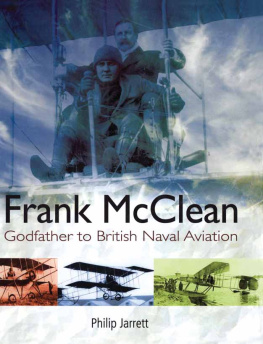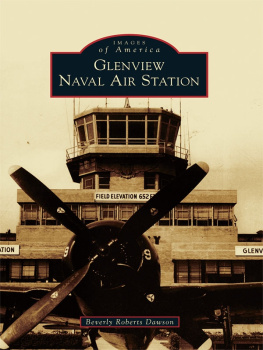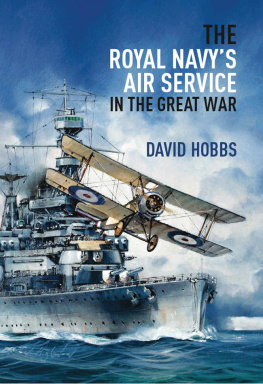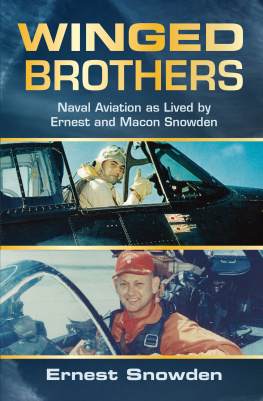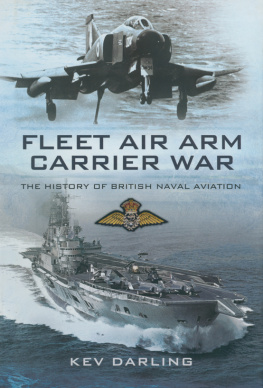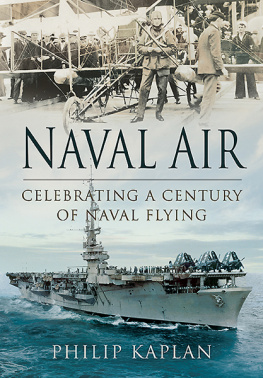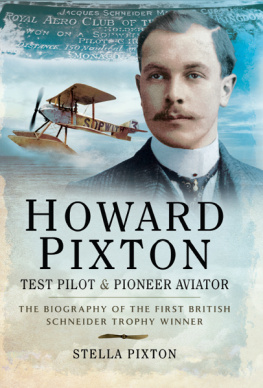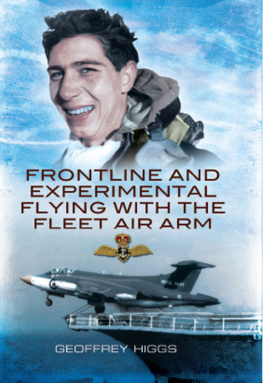TITLE PAGE CAPTION
Frank McCleans Short S.40 moored on the Thames, with the Houses of Parliament providing an imposing backdrop, following his dramatic flight up the river on 10 August 1912. This study epitomises McCleans persistent determination to make the government and the British public aware of the fast-growing capabilities of the aeroplane, and of Britains aviation industry, in the early years of the twentieth century. The advertisement for the Daily Mail on the side of an omnibus on Westminster Bridge is ironic, as that newspaper had promoted the intended flight up the Thames of French aviator Lieutenant de Vaisseau de Conneau, who had to call off his attempt after a mishap in France. (ROYAL AERO CLUB)
Copyright Philip Jarrett 2011
First published in Great Britain in 2011 by Seaforth Publishing,
Pen & Sword Books Ltd,
47 Church Street,
Barnsley S70 2AS
www.seaforthpublishing.com
British Library Cataloguing in Publication Data
A catalogue record for this book is available from the British
Library
ISBN 978 1 84832 109 0
Published in association with the Fleet Air Arm Museum

All rights reserved. No part of this publication may be reproduced or transmitted in any form or by any means, electronic or mechanical, including photocopying, recording, or any information storage and retrieval system, without prior permission in writing of both the copyright owner and the above publisher.
The right of Philip Jarrett to be identified as the author of this work has been asserted by him in accordance with the Copyright, Designs and Patents Act 1988.
Typeset and designed by Neil Sayer
Printed and bound in China
M ention the name Frank McClean to most aviation historians and you might spot a glimmer of recognition, or perhaps something a little more positive from students of British naval aviations early days. His role in instigating and facilitating the training of the first Royal Navy aviators is readily acknowledged, but few are aware of his many additional achievements.
It would be easy to number him dismissively among the moneyed flyers of the pioneer years who bought aeroplanes and flew them for their own sport or pleasure, but Frank McClean invested his vast inherited wealth in Britains national security, and also became heavily involved in aviation safety and in promoting aviation through membership of several Royal Aero Club committees. Nor was he afraid to take an active role, though he seldom sought the limelight unless something or someone urged him into action for a cause. After first becoming an aeronaut and then teaching himself to fly, McClean became the Short brothers voluntary unpaid test pilot for several years. Seeking greater safety, he pioneered the concept of multi-engined aeroplanes, paid for them to be built, tested them, and then made them freely available to naval aviators.
Although a few of his more public exploits drew attention to him, such as the aerial photography experiment over the sunken Oceana, the flight up the Thames to Westminster, and the painfully protracted expedition flight along the Nile, much of his work was carried out quietly, away from the glare of publicity, which he generally shunned. The aeronautical press of the pioneer years often commented on his desire for privacy and lack of response when it sought information. He was happiest when he was flying at Eastchurch, well away from crowded public venues such as Hendon and Brooklands, and this meant that reports of his activities were sparse. He seldom wrote anything for publication at the time, and wrote only two brief accounts of his early flying days subsequently, and they were not widely broadcast. When he did put pen to paper he was dryly witty, and never afraid to have a joke at his own expense. All who knew him held him in reverence, valued his friendship and were impressed by his modesty and even temper.
Although he had no dependants at that time, McClean usually declined to take part in competitions and races. Ironically, when he entered for the round-Britain seaplane race of 1913 his Short S.68 proved a troublesome non-starter. Unlike many other aviators he did not need prize money to finance his flying, and there can be little doubt that the deaths of his close friends the Hon. Charles Rolls and Cecil Grace heightened his awareness of the increased risks entailed in flying competitively. These tragedies did not deter him from flying, but merely led to his becoming involved in accident investigation and in seeking ways to make flying safer. His part in subsequent investigations into the fatal accidents that befell other fellow flyers, such as H J D Astley and S F Cowdery (Colonel Cody), contributed to the effort to pinpoint causes and prevent recurrences.
In some ways McCleans modesty worked against him. When he was awarded a later pilots licence than he clearly merited, owing to his absence when the first British licences were allocated, he made little of it at the time, being more concerned with progress than vain protestation. When his pioneering achievements were belatedly recognised with a knighthood, the honour was bestowed so late that many of his fellow pioneers had passed on before and were conspicuously missing from the celebrations. And, like other pioneers who lived to a good age, he was unknown to many of those who read his obituaries.
But Frank McClean was never one to complain. He was a big man with broad shoulders, and philosophically accepted whatever befell him. He was most active in the early years of the twentieth century, not only ballooning and flying but making long expeditions to remote Pacific islands in attempts to witness eclipses. He evidently enjoyed life, and enjoyed sharing its pleasures (as the ladies he frequently treated to flights were doubtless aware).
Although McClean was never one to sing his own praises, he merits wider recognition for his significant contributions to British aviation in the pioneering era. Without him, the Royal Navy would not have got into the air as early as it did, and it would certainly not have been as prepared as it was when the First World War broke out. Without his patronage and support the Short brothers young company would have struggled to survive in the difficult prewar years. Without him, and others of his ilk, lackadaisical and short-sighted politicians and military leaders might never have perceived the vitally important role that aviation would play in future international conflicts.
I was given the impetus to write this book by Grahame Mottram of the Fleet Air Arm (FAA) Museum, who gave me access to the McClean material donated to the museum by Sir Rupert Carington, and Michael Oakey of Aeroplane Monthly magazine. Although McClean was known to me, in the throes of researching his involvement in the pioneer years of British aviation my eyes were opened. The extent of his commitment, and his farsighted generosity, were truly extraordinary but had gone largely unrecognised. Even many histories of British naval aviation make only a passing reference to his part in its birth.
This account concentrates on Sir Francis Kennedy McCleans life as a pioneer aeronaut and aviator in the exciting pre-First World War years. This was by far the most active and significant period of his life, and, as the record shows, a time of intense and constant involvement in the fast-developing new science of aviation, and in its applications. While his contributions to astronomy, both as an investigator and a benefactor, and his activities during and after the First World War were also noteworthy, it was in the flying world of Edwardian England that Sir Frank made his mark, so his subsequent achievements are summarised in the concluding chapter, in which significant episodes and events are spotlighted.
Next page
